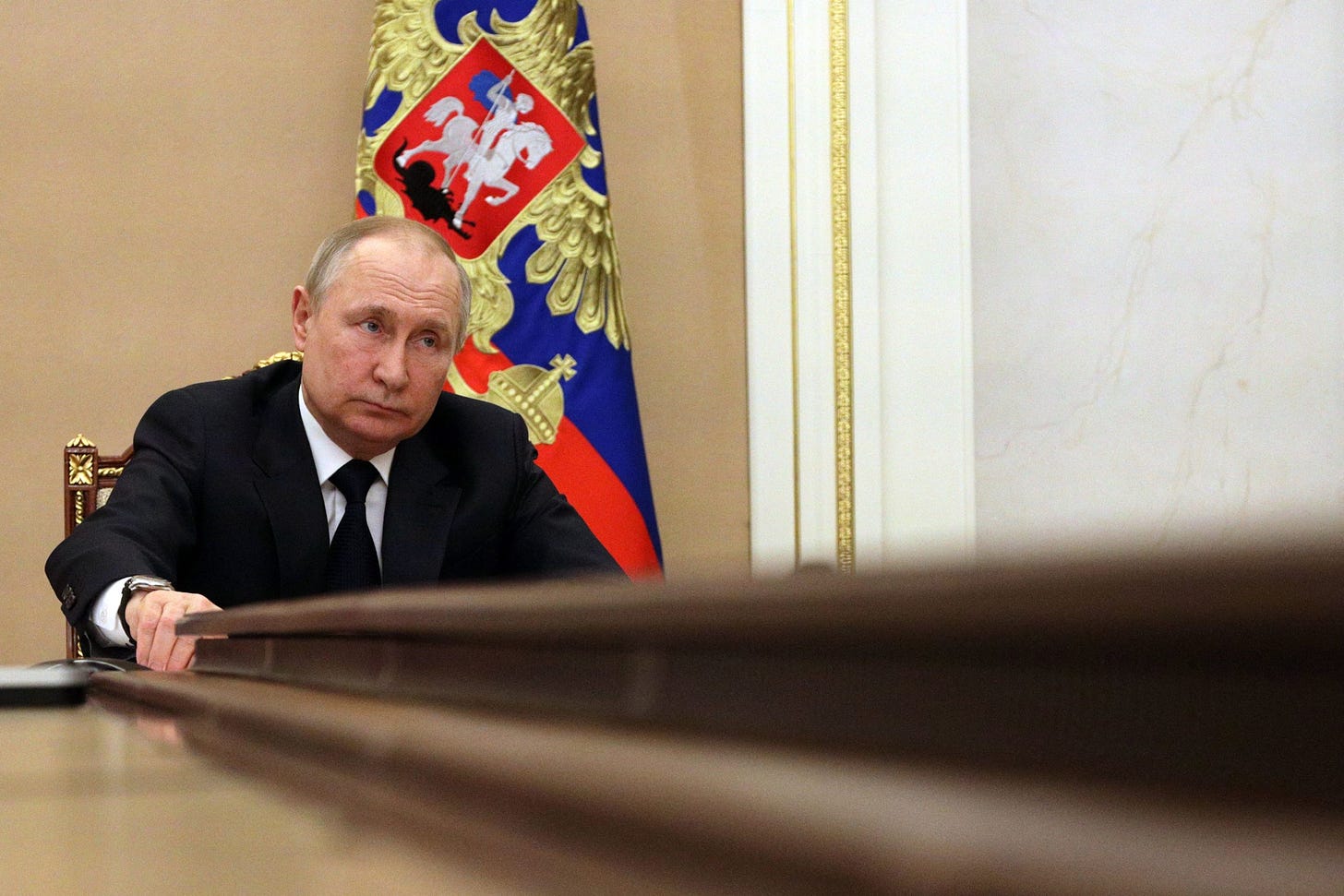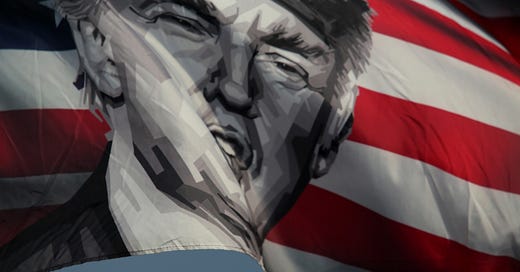
The Clock Is Running Out on Putin’s Invasion
What does victory look like for the Russian dictator, and does he stand a chance of achieving it?

The Russian military has been struggling in the air and on the ground in Ukraine. Now, nearly three weeks into the invasion, it is clear that the Russian strategy in Ukraine was based on misconceptions about the Ukrainian people and Russian military effectiveness. Time is running out for Putin to change course.
Last year, Putin published a very long essay of historical fantasy about Ukraine and how it supposedly is really part of Russia. To judge from his invasion, it seems that Putin believed his own propaganda about Ukrainians: He sincerely thought that the Russians would be greeted as liberators.
Putin entered Ukraine with a force built on his “liberation” fantasy, and that’s a key reason for its difficulties so far. The Russians have repeatedly sought to achieve objectives with insufficient forces—apparently trying, for instance, to conquer cities of hundreds of thousands of inhabitants using just a few thousand troops. Overall, the task of subduing a country of roughly 40 million people now falls to a force of fewer than 200,000 personnel with poor logistical support.
To better understand the options Putin faces, contrast his invasion with an invasion by a force of roughly the same size: the U.S.-led 2003 invasion of Iraq, a country with a population considerably smaller than Ukraine’s.
In 2003, the U.S.-led forces initially conquered Iraq easily in no small part because Iraqi society was divided and many Iraqi soldiers deserted. But the Ukrainian military is far superior to Saddam Hussein’s Iraqi military in terms of morale, training, equipment, and weapons. One likely reason that Russian forces are out of fuel is that Russian troops had been selling it on the black market. Russian forces are not paid well and seem to have little desire to be in Ukraine—which is why this time around it’s the invaders who reportedly have been having trouble with deserters. So many Russian troops have been abandoning their posts and their equipment, Ukrainian President Volodymyr Zelensky joked overnight, that Russia has become “one of the suppliers of equipment for our army.”
In 2003, Hussein was a hated, brutal, and corrupt thug who went into hiding once the shooting started and was not heard of until he was found in a spider hole. By contrast, Zelensky is a democratic, charismatic, and inspirational figure, willing to stay and fight for his country, showing that he won’t ask of his people anything he isn’t willing to do himself.
In 2003, Iraq’s economy had been under sanctions for over a decade, and so its military was neither well trained nor well equipped. By contrast, Ukraine has been receiving foreign military and financial assistance, while Americans have been training the Ukrainian military since 2014.
In 2003, the invading forces came from open, democratic societies where the airing of criticism and opposing views is normal and expected. So when the U.S.-led coalition struggled to pacify Iraqi insurgents, the Bush administration came under intense political pressure to change course. It eventually did, implementing the “Surge” of 2007, which brought with it new ideas as well as new troops. By contrast, Russia’s forces have been ordered into Ukraine by a dictator. The Russian government does not have the channels of dissent or overlapping layers of accountability. For Russians to criticize Putin or the conduct of his war is to put their freedom or their lives in danger. This makes it challenging (to put it lightly) for Putin to be informed about his problems, accept the criticism, and change course. If things had been otherwise, Putin might not have so wildly misunderstood Ukraine in the first place.
For Putin, a change of strategy will require coming clean to the Russian people about the scale of the war, something that would incur a domestic political cost for him. He has obscured the truth about the war from the Russian people, presenting it as a modest escalation of the ongoing war in Donbas. Assuming that Ukrainian military forces continue to hold as well as they have been, and that food and supplies continue to reach the tens of millions of Ukrainian people who haven’t fled the country, Russia will need a greater number of troops to occupy Ukraine—estimates go up to 800,000 troops, roughly the size of the entire Russian military. To achieve this level, Russia would have to call on its reserves, which have all the same problems of the current invading force, but much worse. (Putin has pledged not to call up reservists, not that his word counts for anything.)
Time may be running out for Putin to shift to a winning strategy. Momentum is a major factor in war, and if his forces lose it, they might not be able to get it back. In this sense, the Ukrainians have a structural advantage: Russian victory would require the complete defeat of armed Ukrainian resistance and political control of the country; for the Ukrainians, victory requires only that the resistance continues until the invaders decide to leave, be it in weeks, months, or years.
At least judging by appearances, Putin has made one strategic shift already. After the first few days of war, when Russia failed to achieve a quick victory, the invading forces began their current campaign of mass violence against civilians—without any strategic coherence and without supplying the necessary additional resources. But terrorizing a population into submission has historically had a mixed record of success. The so-called “strategic bombing” during World War II succeeded in exhausting the production resources of Germany and Japan—something Ukraine, thanks to foreign assistance, doesn’t have to worry about as much—but failed to break the will of those countries to fight. Saddam Hussein and Bashar al-Assad both used chemical weapons against their enemies—and both failed to break their enemies’ will to fight. The use of terror arguably worked in the case of the atomic bombs dropped on Japan, but even then, the Japanese cabinet vote for surrender after the second bomb, after four days of deliberations, was a tie, which Emperor Hirohito broke in favor of surrender.
Ruining Ukrainian cities with bombs and artillery is unlikely to have the effect Putin desires—of forcing a Ukrainian surrender—but it will make urban warfare more difficult. The U.S. military can attest to the challenge of urban combat for an occupying force. The challenge is even more difficult in destroyed cities. The grandparents and great-grandparents of the Russian privates in Ukraine, some of whom fought at Stalingrad, would know this well.
By cutting Ukraine off from the Black Sea, Putin may be attempting something like a large-scale siege of the entire country. But as long as Ukraine’s borders with its four nearby NATO-member neighbors—Poland, Slovakia, Romania, and Bulgaria—remain open, this seems unlikely to succeed. And this strategy has a mixed record anyway—history is replete with examples of armies that gave up or ran out of supplies before the fall of the cities they were besieging.
Putin is wasting the time he doesn’t have to adopt a new strategy. His economy is collapsing, and soon he will find it difficult to pay his troops (at least, in any money with appreciable value) and feed his people. The longer this drags out, the likelier it becomes that one or more of his subordinates or super-rich allies will turn on him, a possibility he is wary of and is trying to preempt by purging senior officials. When the military starts to disobey orders and/or Putin’s war chest runs out of money, he won’t be able to adopt a winning strategy even if he could think of one.
[CORRECTION: 3/15/22 6:29 PM— An earlier version of this article suggested Bulgaria shares a border with Ukraine.]









